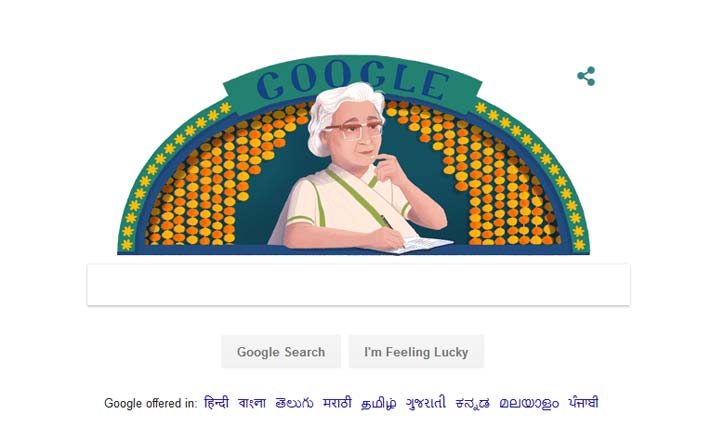 New Delhi:
New Delhi: Today's Google doodle has been dedicated to Urdu writer Ismat Chugtai. Back in the 1930s, Chughtai wrote on female sexuality and femininity, middle-class gentility, and class conflict, subjects considered taboo for the age.
Chughtai established herself as a significant voice in the Urdu literature of the twentieth century. She was awarded the Padma Shri by the Government of India in 1976.
Later she made a mark for herself as a screenwriter, and had several Bollywood hits to her credit. The list includes Arzoo (1950), Faraib (1953) and Sone ki Chidiya (1958). She passed away in 1991, aged 76.
Chughtai's daughter, nephew and niece were married to Hindus. In her own words, Chughtai came from a family of "Hindus, Muslims and Christians who all live peacefully" She was known to be an avid reader of not only the Qur’an, but also the Gita and the Bible. She was cremated in Chandanwadi crematorium in accordance with her wish.
One of the most prominent faces in Urdu literature, Ismat Chughtai was a force to reckon with. Born on August 21, 1911 in Badaun, Uttar Pradesh, Chughtai was one of the pillars in Urdu literature and through her writing she constantly shed light on issues like female desires and sexuality, conflicts of the middle class and their aspirations.
One of her most enduring works remain the short story, Lihaaf (The Quilt). Published in 1942, the story sparked controversy and was criticised for its homoerotic theme. However, Lihaaf is one among a large body of her work. Chughtai has enriched the canon of Urdu literaure with her other works as well.
Here’s looking at her famous short stories and novels.Gainda ( The Marigold)Written after Chughtai moved to Mumbai, Gainda explores the various facets of female sexuality. She wrote about the awakening of sexual desires and urges in young girls and also brought to the fore the double standard of morality. Gainda is the name of a young widow who is sucked into the adult world prematurely owing a child marriage and the story traces how she falls prey to it and is ultimately shamed and chastised.
Lihaaf (The Quilt)One of her most controversial works, Lihaaf deals with the theme of homosexuality. A theme more closely guarded then it is now, it was scathingly criticised and charges of obscenity were levelled against Chughtai. Narrated from a child’s perspective, the story shows how the protagonist Begum Jan, neglected by her husband, creates a space for herself in her household and uses that to articulate her sexual desires.
Gharwali (The Homemaker)Gharwali narrates the tale of Lajjo, the protagonist whom Chughtai invests not only with an awareness of her sexual desires but also with immaculate survival instincts. She feels no shame as Lajjo, a quintessential Chughtai protagonist, treats her sexual urges as a natural instinct. Nothing more and nothing less.
Tedhi Lakeer (The Crooked Line)Considered one of the most celebrated works in Urdu literature, Tedhi Lakeer is Chughtai’s magnum opus. Her protagonist Shama is rebellious, headstrong and through her, Chughtai presents a picture of the way Indian Muslims would live under the colonial rule. She also wrote about women, their desires and struggles.
Til (The Mole)The Mole narrates the tale of an artist who wants to paint a village girl, Rani in the hope of winning some money. Rani, however, distracts him with her sexual charm and relentlessly coaxes and pursues him. Chughtai here places women’s sexual desires on equal footing with that of a man.
 New Delhi: Today's Google doodle has been dedicated to Urdu writer Ismat Chugtai. Back in the 1930s, Chughtai wrote on female sexuality and femininity, middle-class gentility, and class conflict, subjects considered taboo for the age.
New Delhi: Today's Google doodle has been dedicated to Urdu writer Ismat Chugtai. Back in the 1930s, Chughtai wrote on female sexuality and femininity, middle-class gentility, and class conflict, subjects considered taboo for the age.